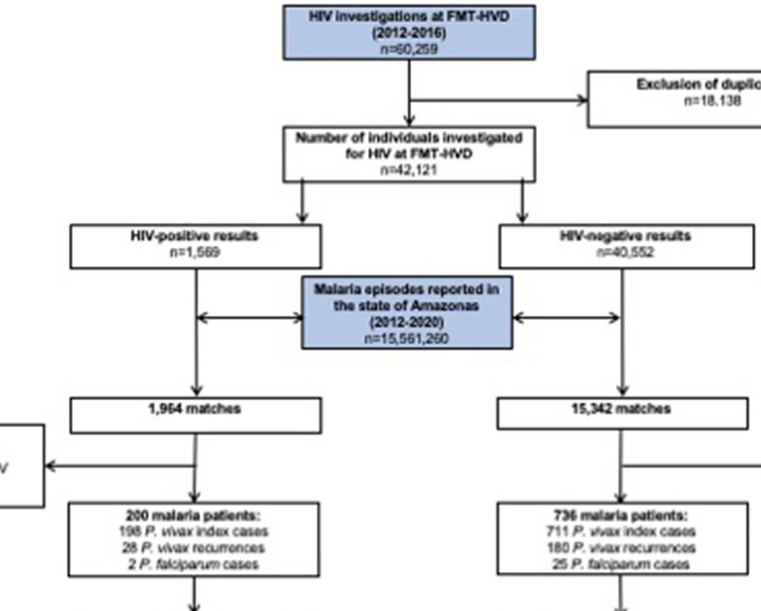HIV infection increases the risk of acquiring Plasmodium vivax malaria: a 4-year cohort study in the Brazilian Amazon HIV and risk of vivax malaria
Globally, malaria and human immunodeficiency virus (HIV) are both independently associated with a massive burden of disease and death. While their co-infection has been well studied for Plasmodium falciparum, scarce data exist regarding the association of P. vivax and HIV. In this cohort study, we assessed the effect of HIV on the risk of vivax malaria infection and recurrence during a 4-year follow-up period in an endemic area of the Brazilian Amazon. For the purpose of this study, we obtained clinical information from January 2012 to December 2016 from two databases. HIV screening data were acquired from the clinical information system at the tropical hospital Fundação de Medicina Tropical Dr. Heitor Vieira Dourado (FMT-HVD). The National Malaria Surveillance database (SIVEP malaria) was utilized to identify malaria infections during a 4-year follow-up period after diagnosis of HIV. Both datasets were combined via data linkage. Between 2012 and 2016, a total of 42,121 people were screened for HIV, with 1569 testing positive (3.7%). Out of all the patients diagnosed with HIV, 198 had at least one episode of P. vivax malaria in the follow-up. In the HIV-negative group, 711 participants had at least one P. vivax malaria episode. When comparing both groups, HIV patients had a 6.48 [(5.37–7.83); P < 0.0001] (adjusted relative risk) greater chance of acquiring P. vivax malaria. Moreover, being of the male gender [ARR = 1.41 (1.17–1.71); P < 0.0001], Amerindian ethnicity [ARR = 2.77 (1.46–5.28); P < 0.0001], and a resident in a municipality of the Metropolitan region of Manaus [ARR = 1.48 (1.02–2.15); P = 0.038] were independent risk factors associated with an increased risk of clinical malaria. Education ≥ 8 years [ARR = 0.41 (0.26–0.64); P < 0.0001] and living in the urban area [ARR = 0.44 (0.24–0.80); P = 0.007] were associated to a lower risk of P. vivax malaria. A total of 28 (14.1%) and 180 (25.3%) recurrences (at least a second clinical malaria episode) were reported in the HIV-positive and HIV-negative groups, respectively. After adjusting for sex and education, HIV-positive status was associated with a tendency towards protection from P. vivax malaria recurrences [ARR = 0.55 (0.27–1.10); P = 0.090]. HIV status was not associated with hospitalizations due to P. vivax malaria. CD4 + counts and viral load were not associated with recurrences of P. vivax malaria. No significant differences were found in the distribution of parasitemia between HIV-negative and HIV-positive P. vivax malaria patients. Our results suggest that HIV-positive status is a risk factor for vivax malaria infection, which represents an additional challenge that should be addressed during elimination efforts.
Authors
Guerra, Cecilia Victoria Caraballo; da Silva, Bernardo Maia; Mi¼ller, Pia; Baia-da-Silva, Djane Clarys; Moura, Marco Antonio Saboia; Araiuo, Jose Deney Alves; Silva-Neto, Alexandre Vilhena; da Silva Balieiro, Antonio Alcirley; da Costa-Martins, Andre Guilherme; Melo, Gisely Cardoso;
External link
Publication Year
Publication Journal
Associeted Project
Digital Epidemiology
Lista de serviços
-
As antisense RNA gets intronic.As antisense RNA gets intronic.
-
Androgen responsive intronic non-coding RNAs.Androgen responsive intronic non-coding RNAs.
-
Conserved tissue expression signatures of intronic noncoding RNAs transcribed from human and mouse loci.Conserved tissue expression signatures of intronic noncoding RNAs transcribed from human and mouse loci.
-
The intronic long noncoding RNA ANRASSF1 recruits PRC2 to the RASSF1A promoter, reducing the expression of RASSF1A and increasing cell proliferation.The intronic long noncoding RNA ANRASSF1 recruits PRC2 to the RASSF1A promoter, reducing the expression of RASSF1A and increasing cell proliferation.
-
Antisense intronic non-coding RNA levels correlate to the degree of tumor differentiation in prostate cancer.Antisense intronic non-coding RNA levels correlate to the degree of tumor differentiation in prostate cancer.
-
Insight Into the Long Noncoding RNA and mRNA Coexpression Profile in the Human Blood Transcriptome Upon Leishmania infantum Infection.Insight Into the Long Noncoding RNA and mRNA Coexpression Profile in the Human Blood Transcriptome Upon Leishmania infantum Infection.
-
Long non-coding RNAs associated with infection and vaccine-induced immunityLong non-coding RNAs associated with infection and vaccine-induced immunity
-
Comparative transcriptomic analysis of long noncoding RNAs in Leishmania-infected human macrophagesComparative transcriptomic analysis of long noncoding RNAs in Leishmania-infected human macrophages
-
SARS-CoV-2 Selectively Induces the Expression of Unproductive Splicing Isoforms of Interferon, Class I MHC, and Splicing Machinery Genes.SARS-CoV-2 Selectively Induces the Expression of Unproductive Splicing Isoforms of Interferon, Class I MHC, and Splicing Machinery Genes.

